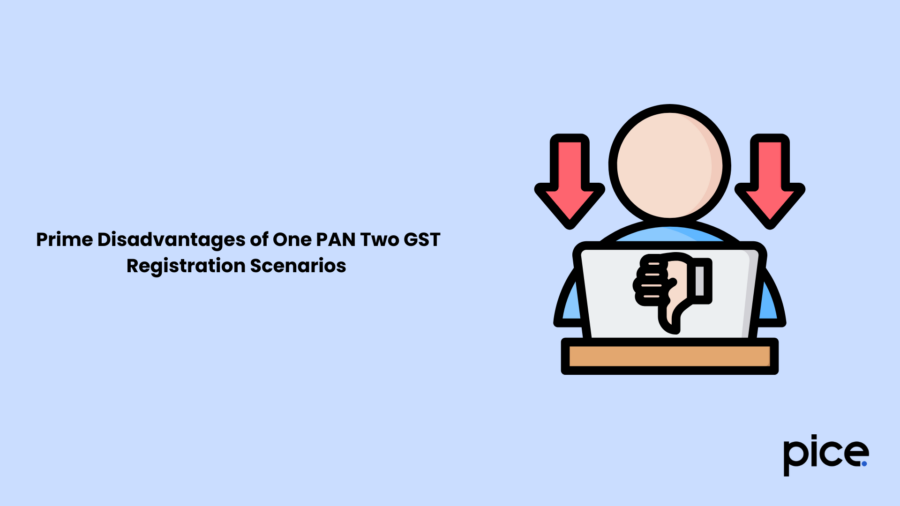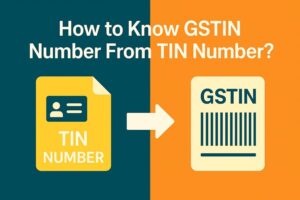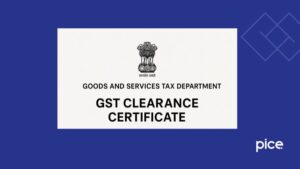One PAN Two GST Registrations: Advantages & Disadvantages
- 13 Jun 25
- 9 mins

One PAN Two GST Registrations: Advantages & Disadvantages
Key Takeaways
- Multiple GST registrations under one PAN are permitted for businesses with distinct verticals or locations within the same state or across states.
- Each GST registration must maintain separate books of accounts and comply with individual tax obligations.
- Entities supplying between business units must treat it as a taxable supply with invoicing, even without consideration.
- Recent amendments allow separate GST registrations within a state based on business location, regardless of vertical differentiation.
- While enabling better tax management, dual GST registrations increase compliance efforts and operational costs.
The Goods and Services Tax (GST) introduced a uniform indirect tax infrastructure in India. It brings the vision of 'One Nation, One Tax' to reality. Under the GST framework, anyone supplying products or services must apply to get a 15-digit unique identification number GSTIN if their aggregate turnover exceeds the prescribed limit or if they fall under the mandatory registration segment.
As per Section 25(1) of the CGST Act, 2017, enterprises operating in different states must opt for separate GST registration in each state under the same PAN. In these cases (one PAN two GST registrations), PAN plays a crucial role, forming a key part of GSTIN.
In general, a single registration covers multiple businesses in the same state. However, as per Section 25(2), entities that are present in different verticals or have branches in distinct locations can obtain separate GST registrations within a state or union territory.
What is Business Vertical?

According to Section 2(18) of the CGST Act, 2017, a business vertical is a distinct part of an entity that supplies goods, services or a related group of both. It is liable to unique risks and GST returns that set it apart from other business verticals within the same enterprise.
In other words, a business vertical refers to a particular market or industry that serves a specific requirement of a particular customer niche. Every service provider focuses on a particular customer segment, and by understanding their needs, they can drive sales by providing customised solutions.
For instance, an entity producing high-quality medical equipment and devices caters exclusively to health organisations. This is a niche market.
Key Requirements for Obtaining Multiple GST Registration Certificates
The CGST Act sets specific guidelines for obtaining separate GST registrations for business verticals while they are in the same state or union territory.
If you consider Rule 11 of the CGST Act, anyone applying for a new registration for their business vertical within the same state needs to adhere to some requirements. That is why checking registration requirements is crucial before applying.
● Anyone (whether an individual or business) applying for a separate GST registration must operate more than one business vertical, as mentioned in Section 2(18) of the CGST Act.
● If any existing business vertical is already registered under the normal scheme, the individual or business cannot choose the composition scheme for the new registration.
● Additionally, if one business vertical does not qualify for GST registration under the composition scheme, no other business verticals will be eligible either.
● The individual or enterprise needs to be involved in interstate supplies.
According to Section 9, every differently registered vertical and branch of a business must pay taxes separately. They are also subject to pay tax on products and services supplied to other verticals since such transactions are treated as supplies to distinct persons. These supplies remain taxable even if the supply is made without consideration. Entities must generate tax invoices for all products and services supplied.
When considering Rule 8(1) of the CGST Act, any business entity operating in a Special Economic Zone (SEZ) or an SEZ developer must apply for a separate GST registration when setting up a vertical outside the SEZ.
If you look at the guidelines further added, then you notice Rule 11(1) specifies that individuals or entities with multiple locations within a state or union territory can apply for a separate registration for each location of the enterprise. However, they are liable to meet the conditions outlined in GST law.
This amendment abolishes the concept of different business verticals. Now, establishments can secure separate GST registrations under the same PAN based on distinct business places, even if they operate under the same business vertical.
The central and state governments have the authority to grant tax exemptions, provided specific criteria are met. These are:
● The exemptions are via notifications.
● They are granted based on the council's recommendations.
● Tax exemptions are in the public interest.
What Happens When the Locations of the Entity Are in Two Distinct States or Union Territories?

According to Subsection (1) of Section 15 of the CGST Act, an enterprise operating in two different states or union territories must obtain two GST registrations for two unique locations of business.
For instance, if your company is based in Kolkata and has a branch in Delhi, your company needs to apply for separate GST registrations as it is located in two distinct places under the same PAN.
What is the Registration Process for One Pan Two GST Registrations?
Here we have described the GST registration procedure when it comes to one PAN, two GST scenarios:
- The applicant needs to visit the official GST portal and click the 'New Registration' option for application for GST registration.
- After that, they need to enter all the necessary details, including the email address for the first GST registration and submit them.
- Once the first registration gets approved, the applicants should apply for the second registration using the same Permanent Account Number (PAN) but with distinct business vertical, business type, place, branch office or warehouse details.
- Lastly, they must click the 'Submit' button for a separate application for the second registration.
Key Advantages of One PAN Two GST Registration Cases
Obtaining two GST registrations while having the same PAN within the same state provides a plethora of benefits. They are:
- Distinct Accounting: By opting for two GST registrations with the same PAN, you can keep different books of accounts for each business vertical, location, branch office or warehouse. This clear distinction not only improves financial transparency but also simplifies management.
- Liable to GST Independently: With each GST registration, you can calculate the tax amount individually for every business unit or segment. This convenience makes the whole tax management process smoother and monitoring GST procedure more efficient.
- Different ITC (Input Tax Credit): With one PAN, two GST registrations, an individual or business can independently avail input tax credits for each business vertical or branch located in two different business locations. Keeping them separate helps you ensure accuracy, efficient credit utilisation and reduced chances of errors.
Prime Disadvantages of One PAN Two GST Registration Scenarios

By opting for two GST certificates under the same PAN, you may have to face certain challenges. They are:
- Higher Compliance Burden: Managing two registrations under the same PAN involves particular compliance processes. It not only makes administrative tasks more complex but also makes the filing process slower. GST officers put in extra effort to ensure every business vertical or branch fulfils legal requirements.
- Increased Costs: Maintaining individual books of accounts, recruiting more staff to handle that additional book of accounts and covering the added administrative costs can remarkably increase expenses. That is why one PAN two GST Registration scenarios often lead to higher overhead costs.
- Complicated Transaction Monitoring Process: Tracking and reconciling separate books of accounts across multiple business segments can make the monitoring process complex. In these cases, keeping accurate financial records and calculating taxes correctly for each registration demands careful attention and effort. So, it is making the process challenging.
Conclusion
GST is linked to an individual’s or business’s PAN and issued for a specific state or union territory. However, a person can apply for separate GSTINs in the same state if they operate more than one business vertical or branch in different locations.
Opting for one PAN two GST registrations offers several advantages but also comes with certain challenges. Taxpayers must research the benefits and compliance requirements before selecting multiple GST registrations within a single state or union territory.
💡If you want to streamline your invoices and make payments via credit or debit card or UPI, consider using the PICE App. Explore the PICE App today and take your business to new heights.
 By
By 
















